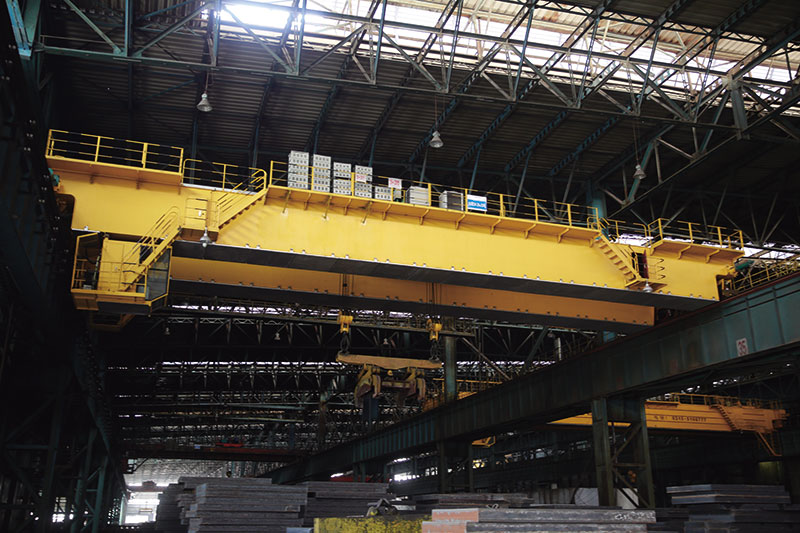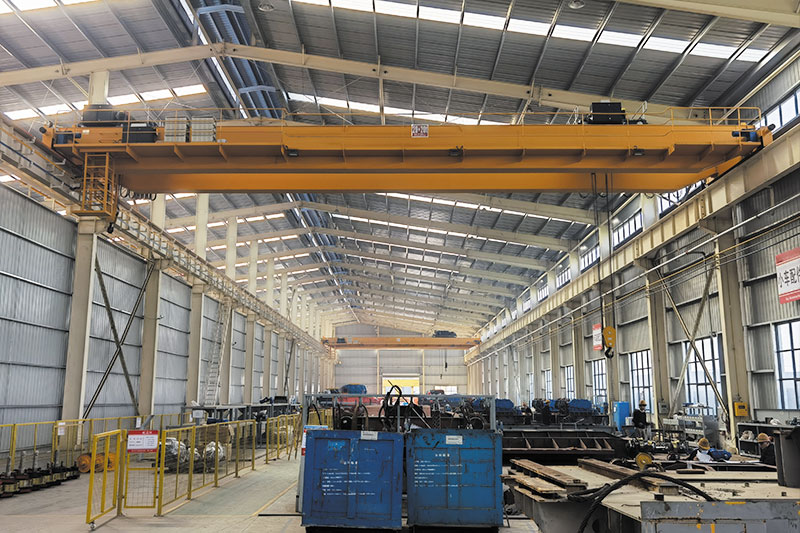Bridge cranes are an essential part of material handling systems in various industries, including manufacturing, construction, and logistics. When designed for lifting heavy loads such as 50 tons, these cranes must be optimized for efficiency, safety, and reliability, especially in operations where lifting is frequent and demanding. Designing a 50-ton bridge crane for frequent lifting operations requires careful attention to several engineering aspects, including load capacity, structural strength, motor and control systems, maintenance considerations, and safety features.
In this article, we will explore the essential elements of designing a 50 ton bridge crane for high-frequency operations, covering both technical and practical considerations that ensure long-term efficiency and safety.

1. Understanding Frequent Lifting Operations
Before diving into the design specifics, it’s important to understand the demands of frequent lifting operations. Cranes used in these settings are expected to handle multiple lifts per hour or even per minute, with varying load requirements. Industries such as steel mills, construction sites, power plants, and warehouses often require cranes capable of moving large, heavy materials swiftly and efficiently.
In frequent lifting operations, the bridge crane must perform reliably under a constant load cycle without failure. This necessitates the selection of robust components, an efficient design, and careful attention to minimizing wear and tear, as the crane will experience constant usage over time.
2. Load Capacity and Duty Cycle
The load capacity of a bridge crane for sale directly impacts its performance. A 50-ton bridge crane must be designed to handle heavy lifting while maintaining precision and control. However, frequent lifting operations can put significant strain on the crane’s components, especially if the load varies or is irregular. The crane design should account for this by incorporating a high-duty cycle rating.
Duty cycle refers to the number of operations a crane is expected to perform within a certain period (usually expressed in terms of hours or shifts). Cranes in high-frequency settings should be designed for higher duty classes (A6, A7, or even A8 in some cases), which ensures that the crane is built for heavy-duty operation. This includes reinforcing critical components, such as the hoist mechanism, wheels, and girder, to prevent premature wear and fatigue.
For instance, if the crane is required to lift 50 tons repeatedly over long hours, the crane’s components should be designed to withstand a high level of mechanical stress without failure. This calls for reinforced hoists and structurally strengthened girders, which we will cover in further detail below.
3. Structural Design for Durability
The structural integrity of a 50-ton bridge crane is paramount, especially in environments where lifting operations are frequent. The crane must be able to handle the stresses of lifting heavy loads continuously while maintaining operational safety.
Girders and Frames:
The main structural components of the crane—girders and frames—must be made of high-strength steel capable of handling both the static and dynamic forces exerted by the load. Steel grades like Q345B or Q460 are commonly used for these components, offering excellent tensile strength and durability. The girder design should provide maximum support while allowing smooth movement along the tracks.
For frequent lifting, the frame’s design must also allow for flexible movement, ensuring minimal strain on the crane when lifting and lowering loads. This can be achieved by using reinforced side plates and incorporating bracing systems to prevent deflection or twisting under load.

Wheels and Tracks:
The crane’s wheels and tracks are under considerable stress during frequent lifting. To ensure smooth travel and minimize wear, it’s crucial to design the wheels with high-quality bearings and use durable materials for the tracks. Rail-mounted wheels made from alloy steel are ideal for minimizing wear. They should be regularly inspected and maintained to avoid misalignment, which could lead to mechanical issues and downtime.
Additionally, the track design should accommodate the frequent movement of the crane without causing excessive friction. Proper alignment and smooth surface finishes on the rails will help ensure efficient and smooth movement during frequent operations.
4. Hoisting Mechanism and Motor Selection
The hoisting mechanism plays a pivotal role in the crane’s ability to lift heavy loads frequently. In a 50-ton bridge crane, the hoist should be equipped with a high-capacity winch capable of handling the weight with precision. The hoist motor must be high-power and energy-efficient, allowing for quick and consistent lifts. For frequent lifting operations, frequency-controlled motors are often preferred as they offer better control over the lifting speed and reduce the wear on the motor.
Double girder designs with redundant hoisting systems are often used in cranes designed for frequent lifting. These systems provide backup lifting capabilities in case of failure, ensuring the double girder bridge crane continues to operate efficiently and safely. The hoist should also feature variable frequency drives (VFD) to adjust the lifting speed as needed, allowing for smoother starts and stops.
Furthermore, the hoist drum and wire rope must be designed to handle the increased wear caused by frequent use. A multi-layer winding design can help extend the life of the rope and prevent tangling, while high-quality wire ropes made from alloy steel are typically used for such applications.
5. Control Systems for Precision and Safety
In frequent lifting operations, precision is key to avoid accidents and damage to the load or the crane itself. The design of the control system plays an important role in ensuring smooth operation, even under high-frequency conditions. Modern 50-ton bridge cranes are often equipped with automated control systems, which provide better accuracy and reduce the potential for human error.
Wireless control systems are commonly integrated into the design of cranes for frequent lifting. These allow operators to control the crane remotely, ensuring they have a clear view of the lifting operation, especially in tight spaces or hazardous environments. The control system should be user-friendly, with intuitive interfaces and emergency stop options for safety.
Safety Features:
For frequent lifting, safety becomes even more crucial. Incorporating safety features such as overload protection, anti-sway systems, emergency brakes, and limit switches into the design can greatly enhance the safety of the crane. Additionally, collision avoidance systems can be implemented to prevent damage to the crane structure or surrounding equipment in high-traffic areas.
Anti-sway technology is especially important in reducing the swinging of heavy loads during operation, which can cause delays and increase the risk of accidents. The crane’s design should include load sensors and active control systems that can automatically adjust the crane’s movements to minimize sway and maintain load stability.
6. Maintenance Considerations
Frequent lifting operations put significant stress on the crane, leading to wear and tear over time. To ensure the crane operates smoothly with minimal downtime, the design must prioritize ease of maintenance. Key components such as motors, gearboxes, and brakes should be easily accessible for inspection and maintenance.
Preventive maintenance systems, such as automatic lubrication systems, should be integrated into the industrial bridge crane design to ensure that the crane’s moving parts remain lubricated, reducing friction and wear. Smart sensors can also be installed to monitor key parts of the crane and alert operators to potential issues before they lead to major breakdowns.
7. Energy Efficiency and Sustainability
With frequent lifting operations, energy consumption becomes a significant concern. A 50-ton bridge crane designed for high-frequency use should be energy-efficient to reduce operational costs. The design should incorporate energy-saving technologies, such as regenerative braking systems, which can convert excess energy during braking into electrical power that can be fed back into the system.
The use of lightweight materials for certain components, such as the crane’s structure, can also help reduce energy consumption during lifting operations. By optimizing the crane’s design for energy efficiency, operators can benefit from lower operating costs while contributing to sustainability efforts.
8. Conclusion
Designing a 50-ton bridge crane for frequent lifting operations requires a careful balance of structural integrity, safety, efficiency, and reliability. Every component, from the motor and hoist mechanism to the structural frame and control systems, must be engineered to withstand the stresses of frequent, high-capacity lifting. Through the integration of advanced safety features, automation, and energy-efficient technologies, it is possible to create a crane that not only meets the demands of frequent lifting operations but also ensures longevity, minimal downtime, and a safe working environment.
By taking these considerations into account, businesses can maximize the performance and lifespan of their 50-ton bridge crane, ensuring it remains a vital asset in their material handling operations.
